Laboratories and Infrastructure
LABORATORY:
Plant tissue culture
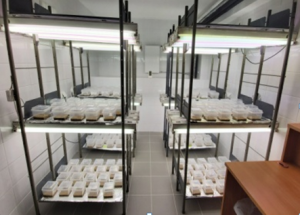 Plant research commonly involves growing plants in a controlled environment. These plants may be inoculated with different microorganisms, e.g. pathogens or promoting plant growth. The main motive is to maintain as sterile environment as much as possible. Preparation of plant sample mainly involves inoculation of seeds or plant tissue under aseptic conditions (HEPA filtered air-Laminar flow cabinet) followed by growing the seeds or plant tissue contained in sterile containers such as flasks, petri dish or magenta boxes in a growth room with controlled temperature and light (LED) intensity.
Plant research commonly involves growing plants in a controlled environment. These plants may be inoculated with different microorganisms, e.g. pathogens or promoting plant growth. The main motive is to maintain as sterile environment as much as possible. Preparation of plant sample mainly involves inoculation of seeds or plant tissue under aseptic conditions (HEPA filtered air-Laminar flow cabinet) followed by growing the seeds or plant tissue contained in sterile containers such as flasks, petri dish or magenta boxes in a growth room with controlled temperature and light (LED) intensity.
Plant pathology
Plant Pathology Lab is to study problems related to the management and control of economically important crop plant diseases. The research concerns plant diseases caused by two major types of phytopathogens: intracellular pathogens (i.e. viruses and viroids and) and prokaryotes (mainly bacteria). We study plant resistance to biotic and abiotic stress. The research adresses ecological and molecular bases of host-pathogen interaction and the development of new control strategies.
Laboratory of in-vitro cultures
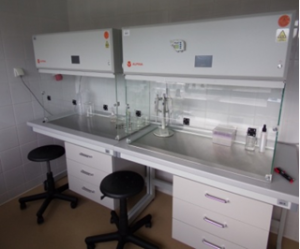
Plant tissue culture lab consists of one cutting room and two growth chambers. Cutting room is equipped with two UV-sterilized laminar flow stations where explants are micropropagated. Growth chambers are equipped with cultivation shelves and controllable light sources to provide optimal growth conditions for plants. In this lab plant tissues and organs are grown in vitro on artificial media, under clean and fully controlled environment. The plant tissue culture constitutes an indispensable tool in modern agriculture, because it has significant contribution to the advancement of agricultural sciences. We use it to study plant-pathogen-symbiont interactions in controlled environment.
EQUIPMENT:
Microscopy Zeiss Axiostar Plus
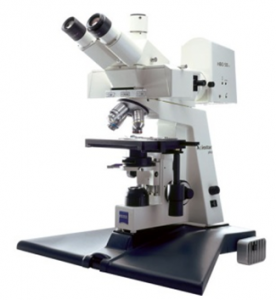 The Axiostar plus is a transmitted light microscope with fluorescence module with linear slider and three filter positions. It‘s ideal for single and double stained fluorescence, for the visualization of fine structures and forms in biology and medicine. HBO light sources provide the right spectral light intensity and the integrated light trap guarantees high contrast images. Microscope is equipped with high-resolution ICS (infinity color-corrected optics system) 10x, 40x, 100x A-Plan objectives. Microscopy is connected with camera DLT-Cam Pro 6,3 MP and software DLT-Cam Viewer.
The Axiostar plus is a transmitted light microscope with fluorescence module with linear slider and three filter positions. It‘s ideal for single and double stained fluorescence, for the visualization of fine structures and forms in biology and medicine. HBO light sources provide the right spectral light intensity and the integrated light trap guarantees high contrast images. Microscope is equipped with high-resolution ICS (infinity color-corrected optics system) 10x, 40x, 100x A-Plan objectives. Microscopy is connected with camera DLT-Cam Pro 6,3 MP and software DLT-Cam Viewer.
For more information: https://www.zeiss.com/microscopy/int/home.html
Stereo Microscope Carl Zeiss Stemi 2000-C
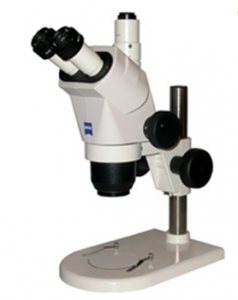 The Zeiss Stemi 2000-C microscope has a zoom range of 0.65x -5.0x. With the included 10x / 23mm FOV eyepieces this microscope gives a total magnification range of 6.5x – 50x. It has click stops at 0.65, 0.8, 1.0, 1.25, 1.6, 2.0, 2.5, 3.2, 4.0, and 5.0 zoom settings. The trinocular viewing head allows for adding a camera DLT-Cam Pro 6,3 MP to this microscope. Microscopy is connected with Zeiss KL 1500 LCD cold light source.
The Zeiss Stemi 2000-C microscope has a zoom range of 0.65x -5.0x. With the included 10x / 23mm FOV eyepieces this microscope gives a total magnification range of 6.5x – 50x. It has click stops at 0.65, 0.8, 1.0, 1.25, 1.6, 2.0, 2.5, 3.2, 4.0, and 5.0 zoom settings. The trinocular viewing head allows for adding a camera DLT-Cam Pro 6,3 MP to this microscope. Microscopy is connected with Zeiss KL 1500 LCD cold light source.
For more information: https://www.zeiss.com/microscopy/int/home.html
Lyophilizer LyoQuest (DAN LAB, Telstar)
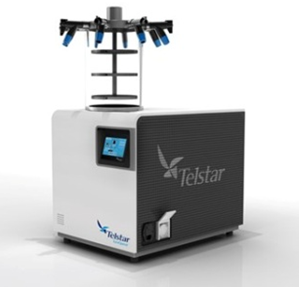 Lyophilizer – freeze dryer executes a water removal process typically used to preserve perishable materials, to extend shelf life or make the material more convenient for transport. Lyophilizers work by freezing the material, then reducing the pressure and adding heat to allow the frozen water in the material to sublimate. In our Department lyophilizer is used to freeze dry sterile plant material to longer storage or to molecular analyses.
Lyophilizer – freeze dryer executes a water removal process typically used to preserve perishable materials, to extend shelf life or make the material more convenient for transport. Lyophilizers work by freezing the material, then reducing the pressure and adding heat to allow the frozen water in the material to sublimate. In our Department lyophilizer is used to freeze dry sterile plant material to longer storage or to molecular analyses.
For more information:
https://danlab.pl/nasze-produkty/urzadzenia-chlodnicze/liofilizatory/liofilizatory-lyoquest/
pH-meter – conductivity meter (CPC-505, Elmetron)
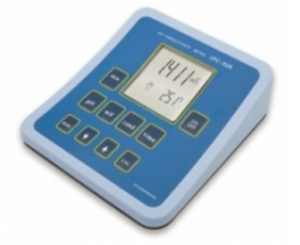 This equipment measures: pH, redox potential, conductivity, resistivity, salinity, TDS and temperature. It is necessary to preparation different media and solutions and to analysis of physicochemical properties of soil or water used in experiments.
This equipment measures: pH, redox potential, conductivity, resistivity, salinity, TDS and temperature. It is necessary to preparation different media and solutions and to analysis of physicochemical properties of soil or water used in experiments.
For more information: https://elmetron.com.pl/CPC-505.html
Sonic ruptor 250
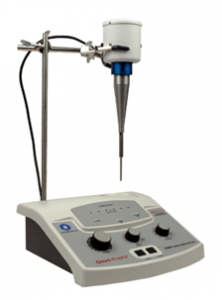 Sonicator – ultrasonic homogenizer, its mechanism of action is based on an ultrasonic cavitation, which results in the formation of microscopic vapor bubbles, which, by imploding, generate shock waves causing intensive mixing or grinding of liquids and suspensions. It is used for the homogenization of immiscible liquids, dispersion and deagglomeration of solids in liquids, e.g. nanoparticles, degassing liquids, accelerating chemical and enzymatic reactions, stimulating bacterial activity, or disintegrating cells and tissues.
Sonicator – ultrasonic homogenizer, its mechanism of action is based on an ultrasonic cavitation, which results in the formation of microscopic vapor bubbles, which, by imploding, generate shock waves causing intensive mixing or grinding of liquids and suspensions. It is used for the homogenization of immiscible liquids, dispersion and deagglomeration of solids in liquids, e.g. nanoparticles, degassing liquids, accelerating chemical and enzymatic reactions, stimulating bacterial activity, or disintegrating cells and tissues.
For more information: https://pdf.directindustry.com/pdf/omni-international/omni-sonic-ruptor-ultrasonic-homogenizer/63078-116158.html
Spectrometer Nanodrop
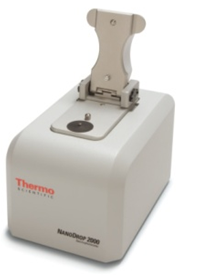 Thermo Scientific NanoDropTM 2000/2000c – is full-spectrum UV-Vis spectrophotometer. Their application involves quantification and assessment of purity of DNA, RNA, Protein and others. It has the capacity of measuring sample volumes as small as 0.5 μL with high accuracy and reproducibility.
Thermo Scientific NanoDropTM 2000/2000c – is full-spectrum UV-Vis spectrophotometer. Their application involves quantification and assessment of purity of DNA, RNA, Protein and others. It has the capacity of measuring sample volumes as small as 0.5 μL with high accuracy and reproducibility.
For more information:
https://www.thermofisher.com/order/catalog/product/ND-2000#/ND-2000
UVP MultiDoc-It UV Transilluminator
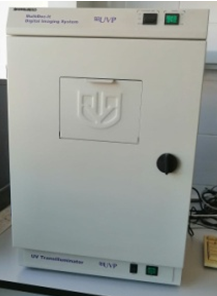 The sturdy housing of the MultiDoc-It is for multiple user laboratories capturing gel images. For imaging in Thin Layer Chromatography (TLC) applications, the system is available without a transilluminator. Wide access door with UV-safe viewing window provide easy and safe way to observe gel that is inside transilluminator. Camera mounted on top of darkroom with ethidium bromide filter guarantees high quality of pictures. MultiDoc-It software lets user change various paramiters like aperture, contrast, brigtness zoom etc. Instrument is used to confirm presence of nucleic acids aquired after PCR and electrophoresis. Photos can be easly saved in common formats like jpg. or png..
The sturdy housing of the MultiDoc-It is for multiple user laboratories capturing gel images. For imaging in Thin Layer Chromatography (TLC) applications, the system is available without a transilluminator. Wide access door with UV-safe viewing window provide easy and safe way to observe gel that is inside transilluminator. Camera mounted on top of darkroom with ethidium bromide filter guarantees high quality of pictures. MultiDoc-It software lets user change various paramiters like aperture, contrast, brigtness zoom etc. Instrument is used to confirm presence of nucleic acids aquired after PCR and electrophoresis. Photos can be easly saved in common formats like jpg. or png..
For more information:
https://www.uvp.com/products/bioimaging-systems/basic-imaging-systems/uvp-multidoc-it/
SpectraMax iD3
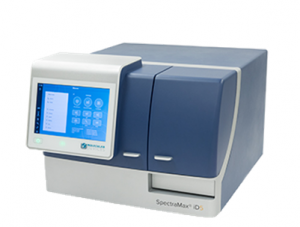 The SpectraMax iD3 Multi-Mode microplate reader is modern, multifunctional apparatus dedicated for running the experiments based on the measurements of absorbance, fluorescence or luminescence in 96 or 386 samples analyzed at the same time. Depending on the specific experimental requirements, the samples can be incubated in the device-integrated incubator module, under controlled conditions, including user-desirable temperature, time and agitation profile.
The SpectraMax iD3 Multi-Mode microplate reader is modern, multifunctional apparatus dedicated for running the experiments based on the measurements of absorbance, fluorescence or luminescence in 96 or 386 samples analyzed at the same time. Depending on the specific experimental requirements, the samples can be incubated in the device-integrated incubator module, under controlled conditions, including user-desirable temperature, time and agitation profile.
The SpectraMax iD3 Multi-Mode microplate reader is relevant for:
- Absorbance-based measurements including:
- Microorganism growth curve via optical density (OD)
- Minimum Inhibitory Concentration (MIC) test
- Cell viability, cell proliferation, cytotoxicity assay
- Colorimetric quantification of specific compound concentration (e.g. proteins)
- Enzyme activity assay and enzyme kinetics
- Immunoassays/different types of ELISA (i.e. quantification of antigens, antibodies, cytokines)
- Quantification of nucleic acids (i.e. DNA, RNA)
- Endotoxin assays
- Fluorescence-based assays including:
- High-sensitivity fluorescent quantification of DNA, RNA and proteins
- Nanoparticle assays
- cAMP assays
- Calcium assays (examination of cell signaling via G protein-coupled receptors)
- Cell proliferation and apoptosis assays
- Cytotoxicity assays
- Luminescence-based assays including:
- Luciferase reporter gene assays
- Reactive oxigen species (ROS) quantification (e.g. determination of lipid peroxidation level)
- ATP-based cell viability assays
For more information: https://www.moleculardevices.com/products/microplate-readers/multi-mode-readers/spectramax-id3-id5-readers
Roche LightCycler® 480 Instrument II
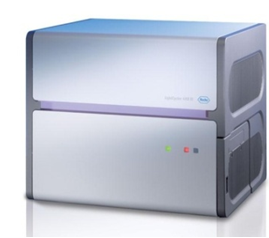 The LightCycler® 480 System is a high-performance, automated, medium- to high-throughput PCR platform (96-well plates) that provides various methods for gene detection, gene expression analysis, genetic variation analysis, and array data validation. Real time PCR can generate a fluorescence signal by using fluorescence labelled probes, allowing us to detect and semi quantify the amount of amplified DNA. This instrument is used for the detection and quantification of plant gene expression, 16S (bacteria) and ITS (fungi) or gene of interest.
The LightCycler® 480 System is a high-performance, automated, medium- to high-throughput PCR platform (96-well plates) that provides various methods for gene detection, gene expression analysis, genetic variation analysis, and array data validation. Real time PCR can generate a fluorescence signal by using fluorescence labelled probes, allowing us to detect and semi quantify the amount of amplified DNA. This instrument is used for the detection and quantification of plant gene expression, 16S (bacteria) and ITS (fungi) or gene of interest.
For more information https://lifescience.roche.com/en_pl/products/lightcycler14301-480-instrument-ii.html
SOFTWARES:
Sequencher version 5.4.6 [Gene Codes Corporation]
Sequencher is a DNA sequence editing tool. You can look at your chromatogram data one sequence at a time or view multiple aligned chromatograms in both forward and reverse orientations. Sequencher makes traditional sequence assembly easy while keeping you in control. The Sequencher features include: Trim your sequences for poor quality data with ease. Selection of the best algorithm for your data including Assemble to Reference and if you are working with multiple samples from different sources then automate the assembly using Assemble by Name. Editing your data with tools to help you locate and deal with ambiguities, check for heterozygotes and move around your data.
For more information: http://www.genecodes.com/
Statsoft Statistica 13.3.721.1
The Statistica program is widely used all over the world and is applicable to every industry. Its main advantages are: a set of the most modern analytical tools, ease of use and rich data visualization possibilities. Additional specialized analytical kits prepared by the StatSoft Polska team make work even more convenient and effective. The program allows you to calculate virtually all commonly used descriptive statistics, including medians, modal values, quartiles, user-specified percentiles, means and standard deviations, quartile ranges, confidence intervals for the mean, asymmetry and kurtosis coefficients (with appropriate standard errors) , harmonic averages, geometric and many others. The program also allows you to perform advanced analyzes such as regression or correlation, PCA, etc. that are commonly used during day to day statistics required for research
For more information: https://www.statsoft.pl/
Rotary evaporator with water bath, vacuum pump and cooling system
A rotary evaporator with a water bath, vacuum pump, and cooling system is used primarily for the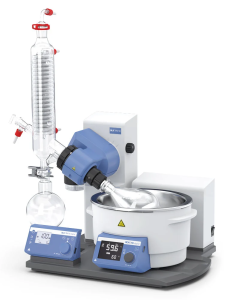 efficient and gentle removal of solvents from samples by evaporation. The combined setup allows efficient solvent evaporation while protecting heat-sensitive compounds and enabling safe, controlled recovery of volatile solvents. It holds diverse applications in fields such as organic chemistry, pharmaceutical research, and food analysis for the following reasons:
efficient and gentle removal of solvents from samples by evaporation. The combined setup allows efficient solvent evaporation while protecting heat-sensitive compounds and enabling safe, controlled recovery of volatile solvents. It holds diverse applications in fields such as organic chemistry, pharmaceutical research, and food analysis for the following reasons:
Concentration of Solutions: It’s commonly used to concentrate solutions by evaporating excess solvents. This helps concentrate samples or prepare them for further analysis or reaction.
Solvent Removal: The rotary evaporator can efficiently remove organic solvents from a mixture without excessive heating, which is ideal for heat-sensitive compounds that might degrade if exposed to high temperatures. The low pressure from the vacuum pump lowers the boiling point of the solvent, allowing it to evaporate at lower temperatures.
Purification and Extraction: Researchers use rotary evaporation to purify compounds by selectively evaporating solvents with different boiling points, making it useful in separating certain compounds from mixtures or isolating specific extracts, such as essential oils.
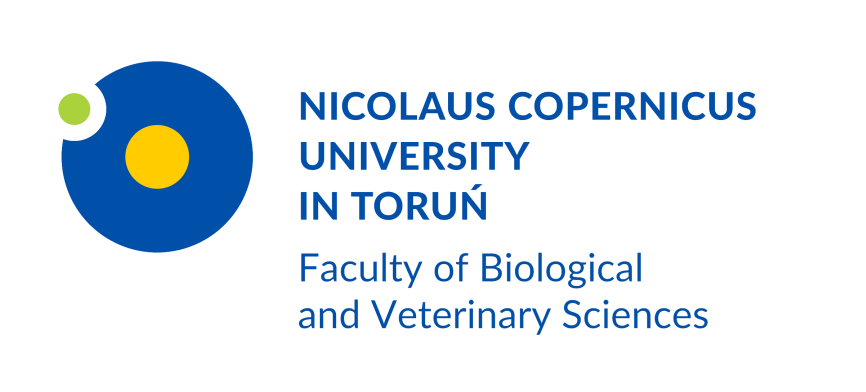
 ul. Lwowska 1, 87-100 Toruń
ul. Lwowska 1, 87-100 Toruń



